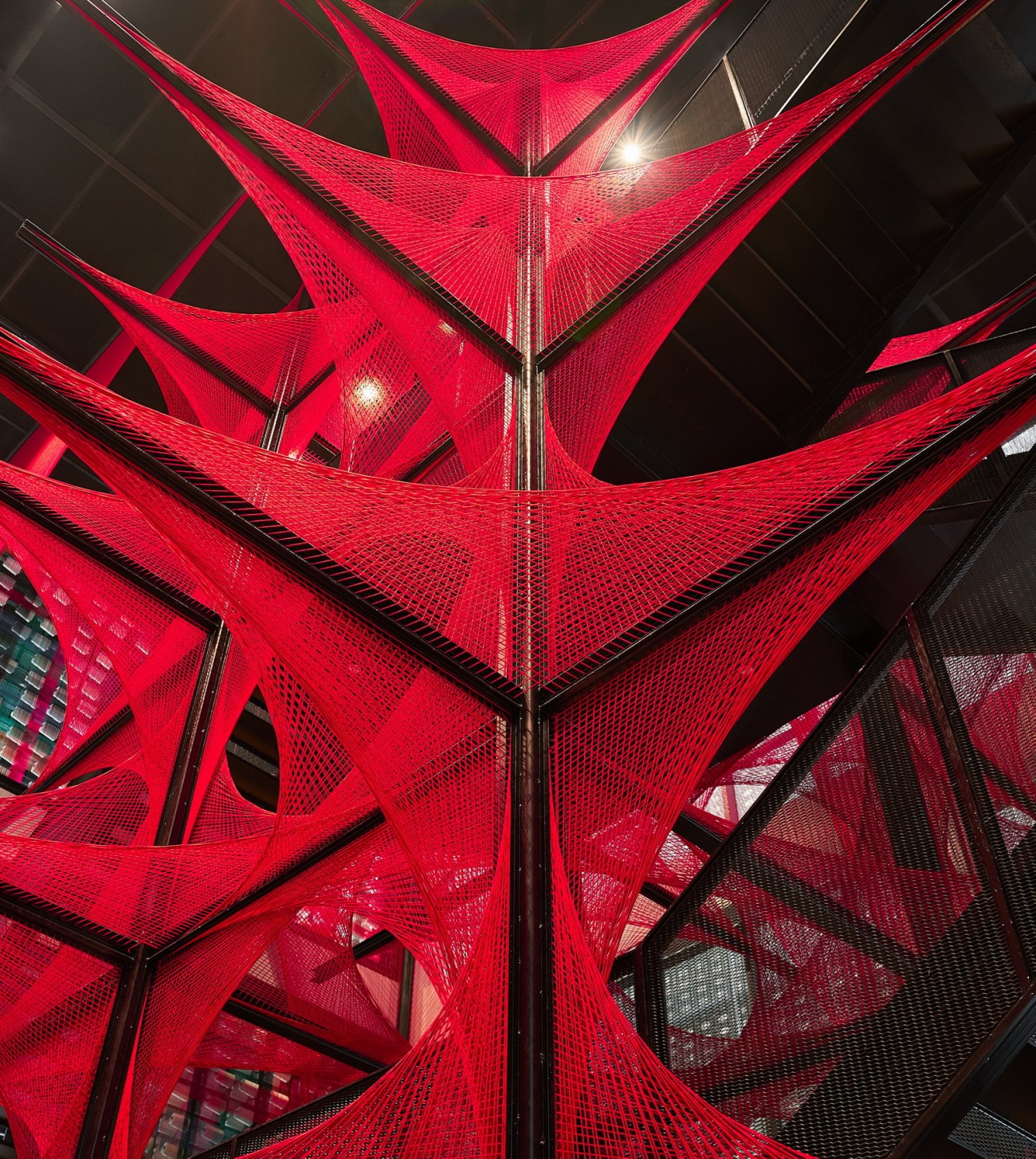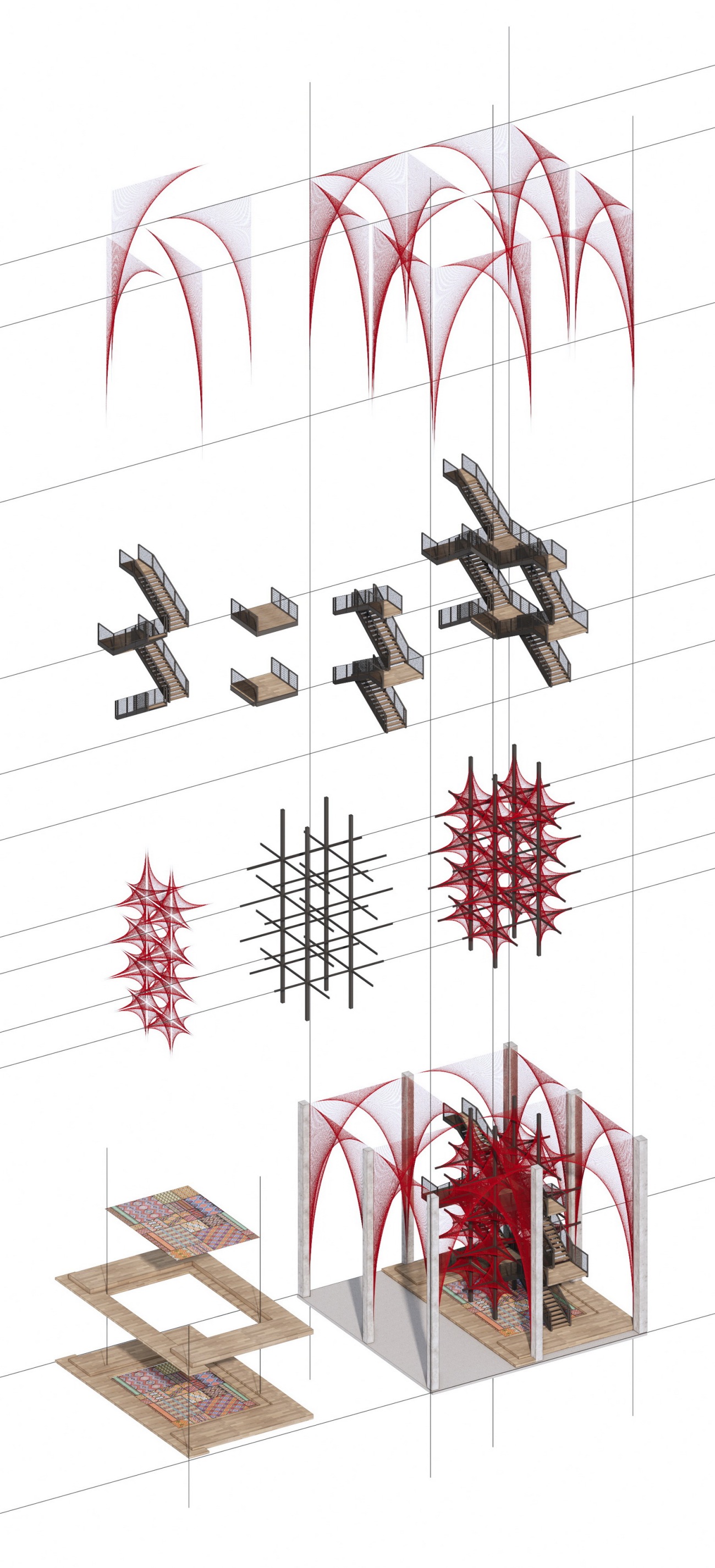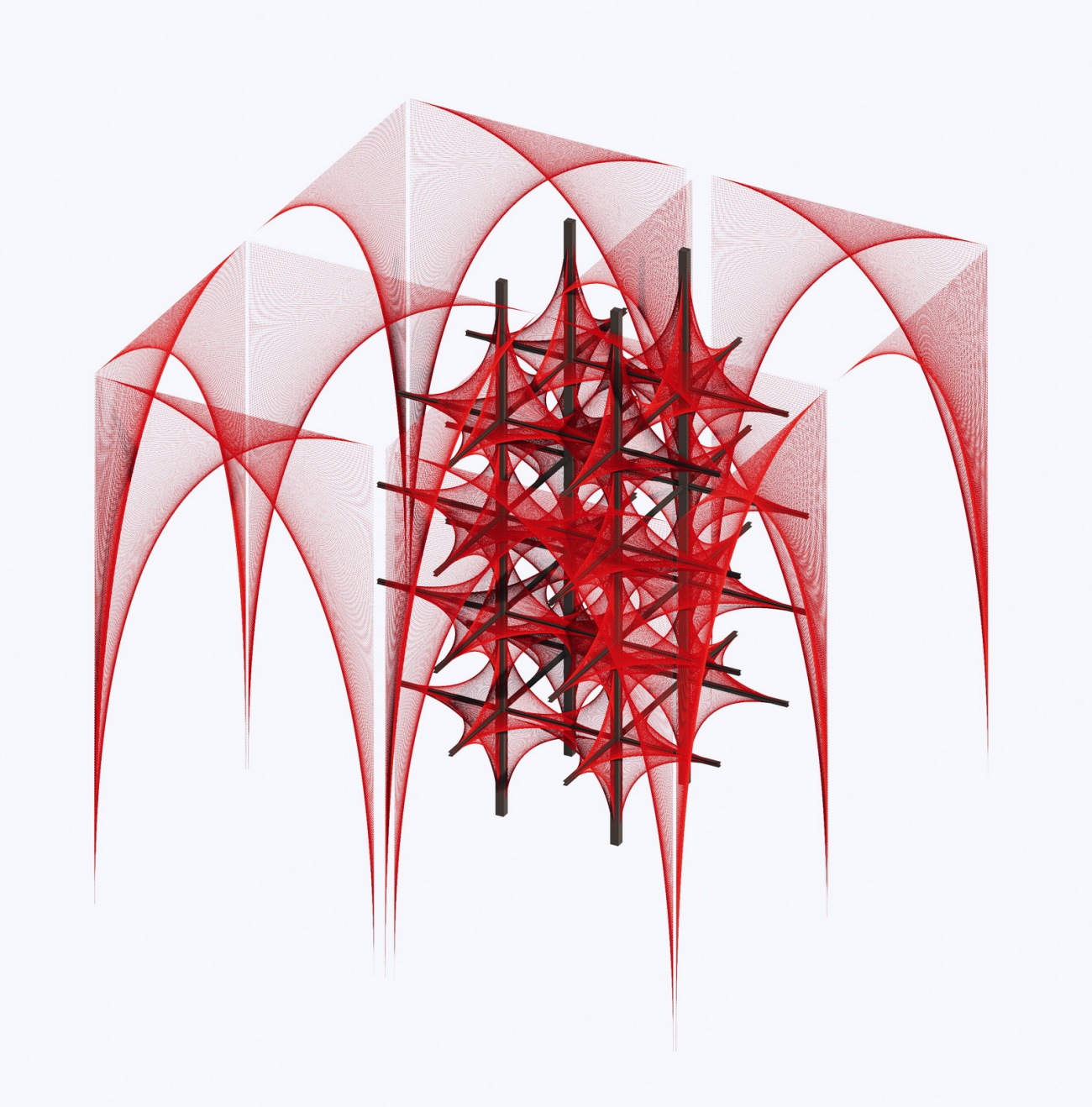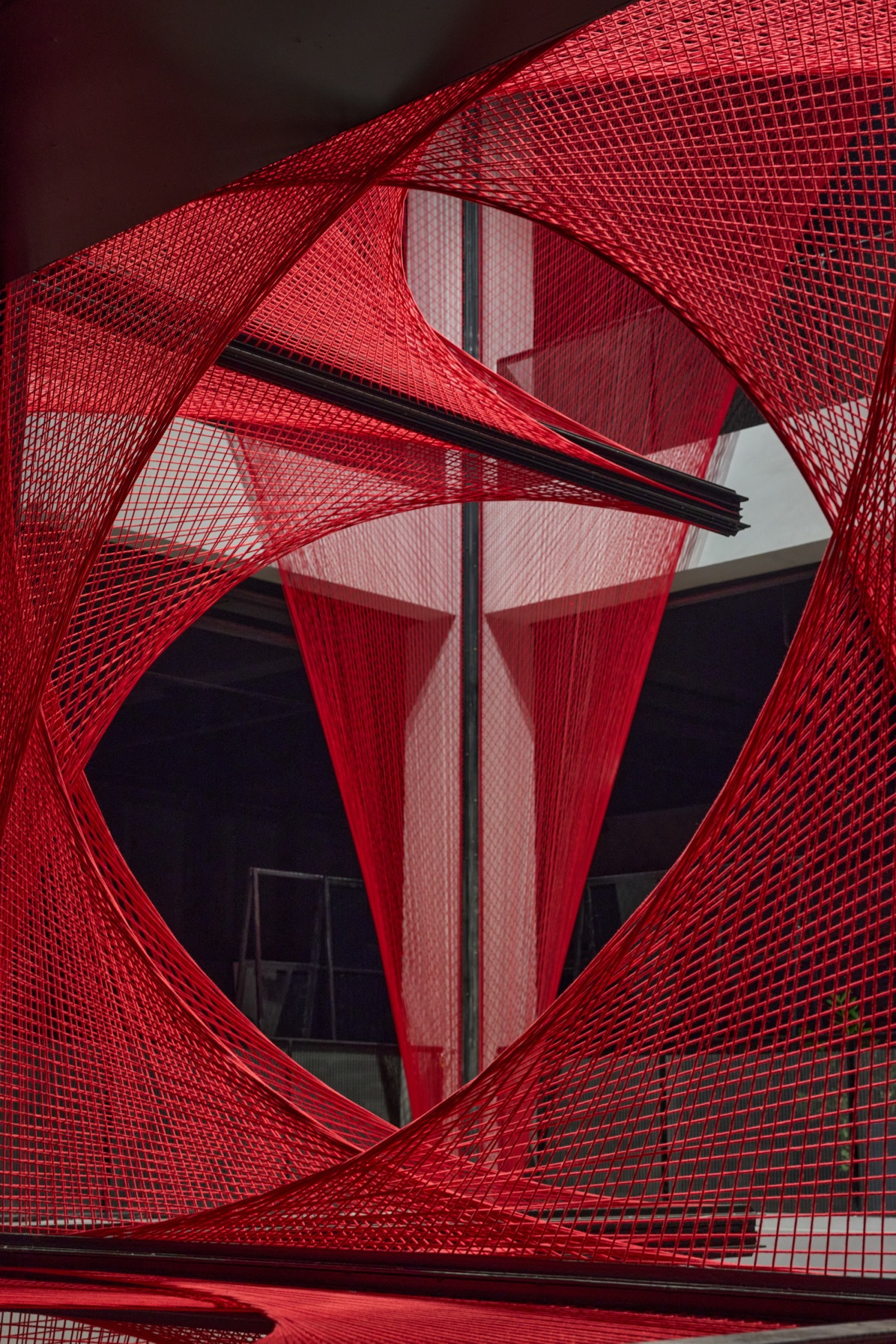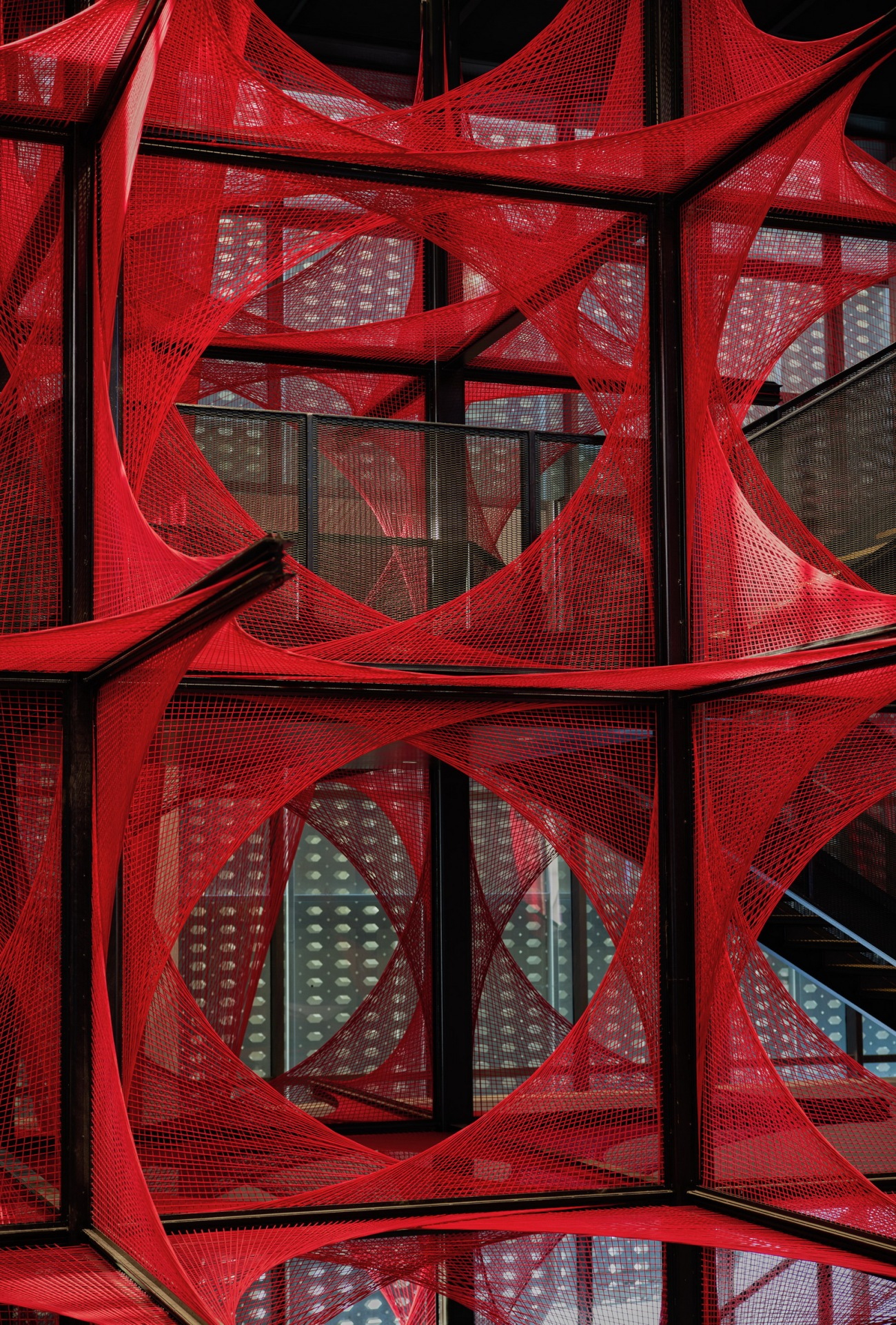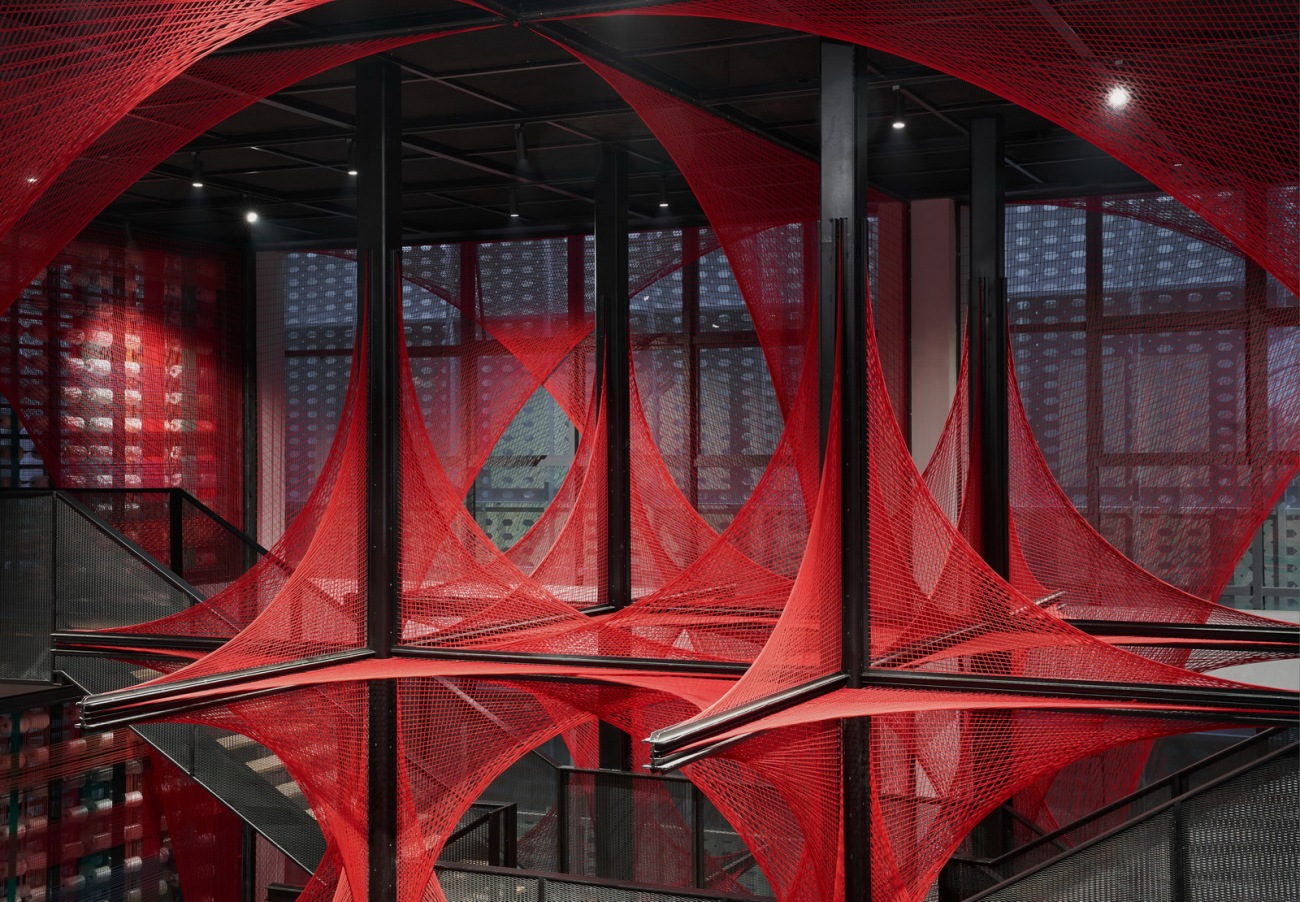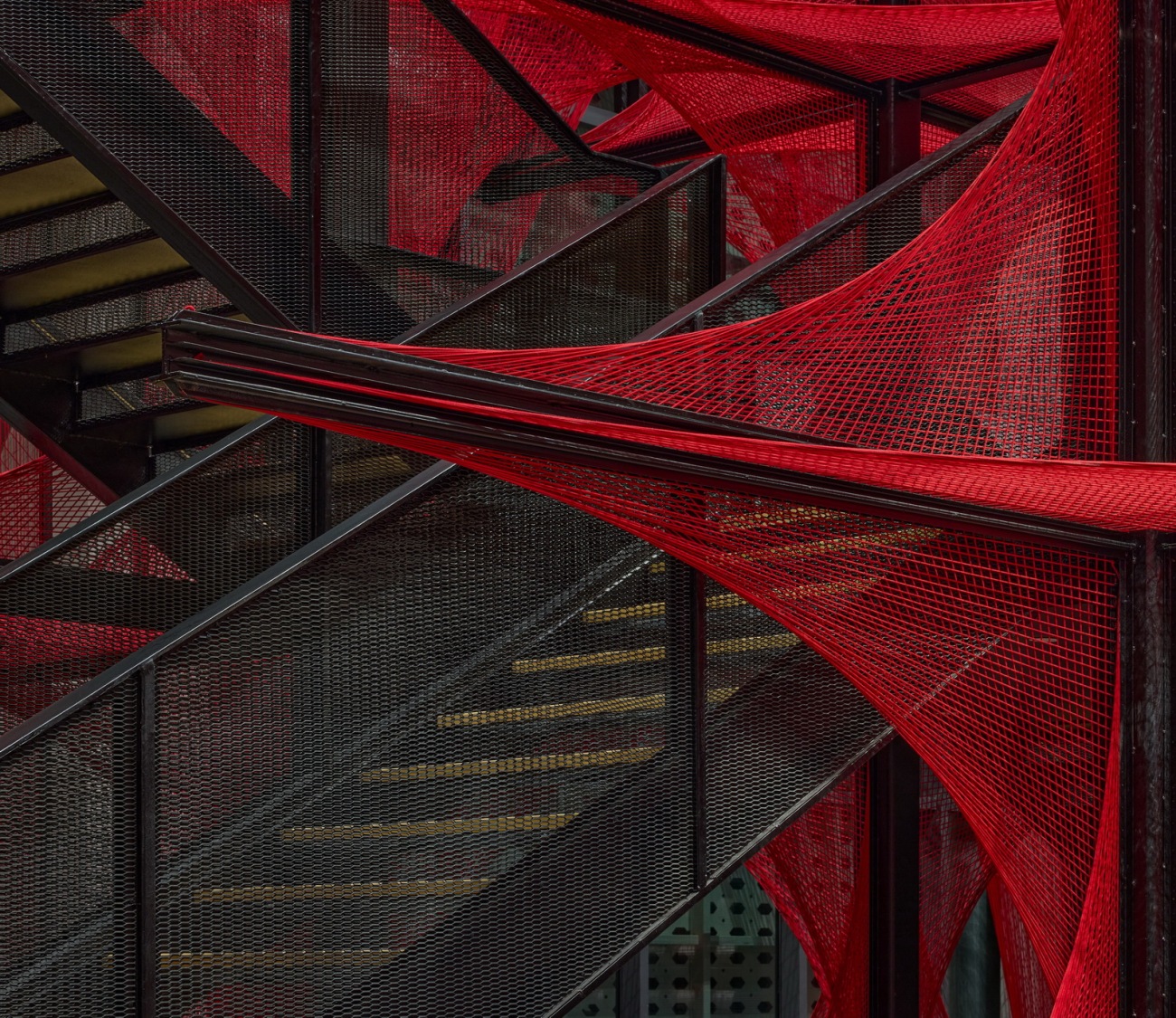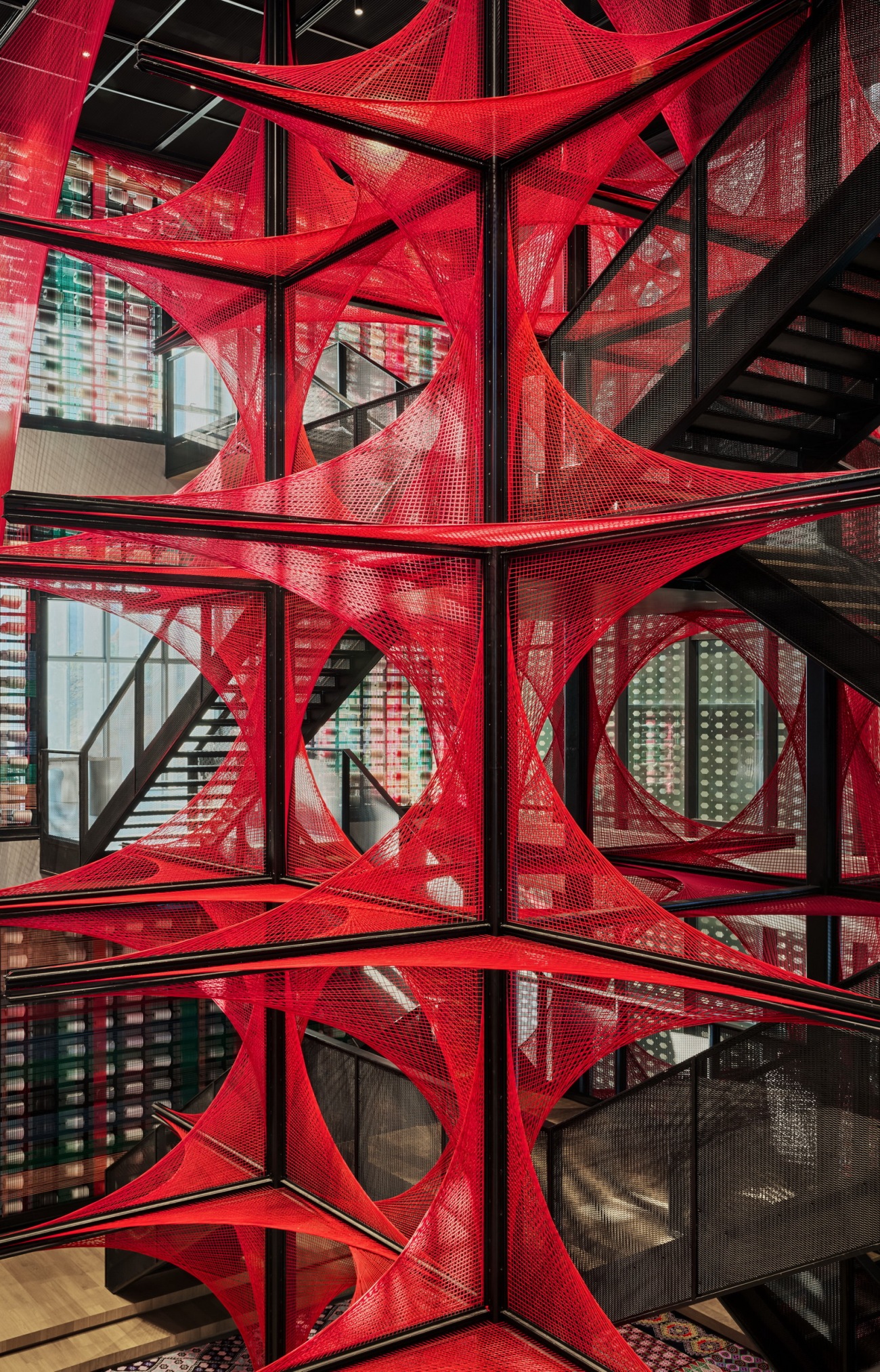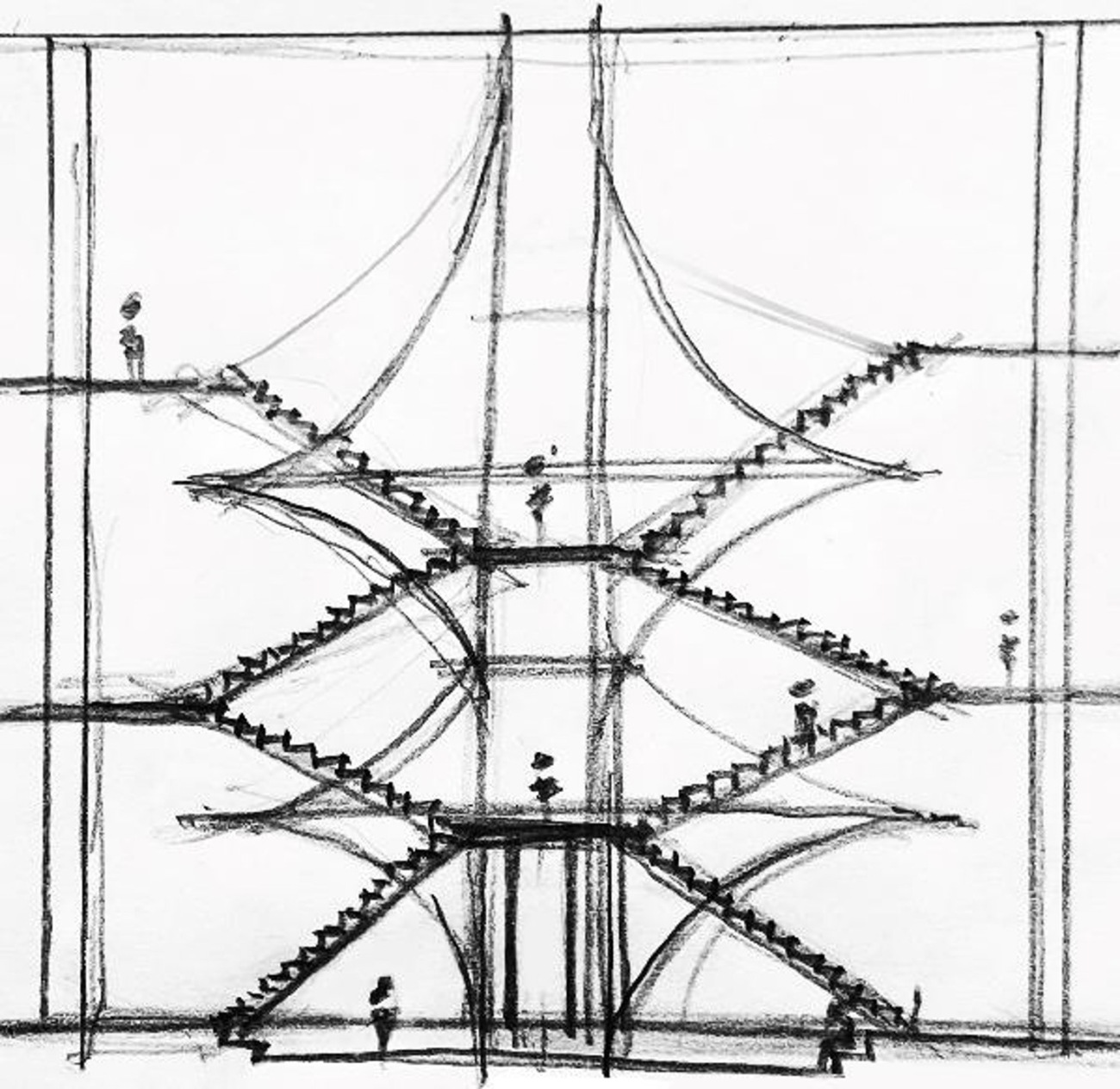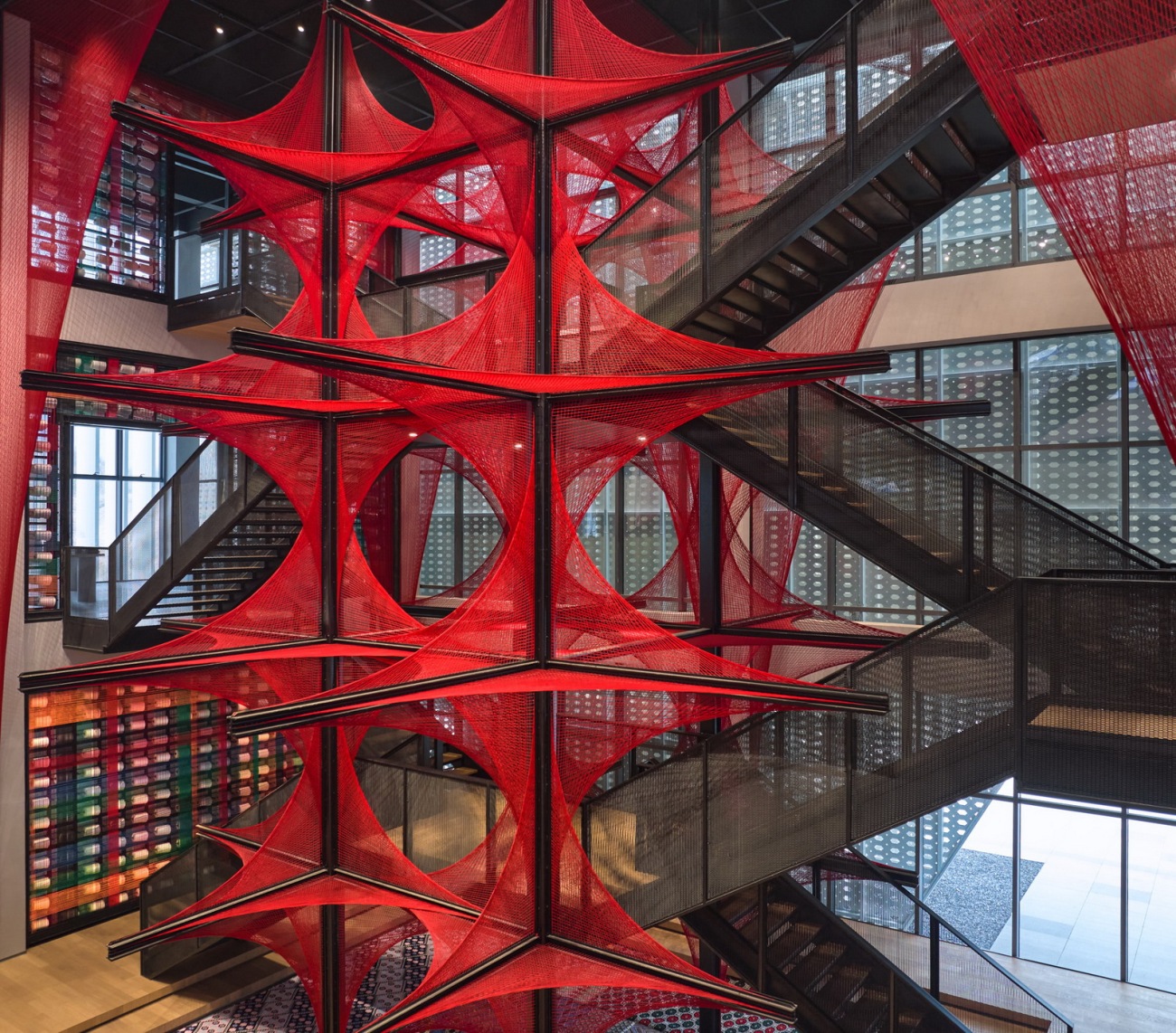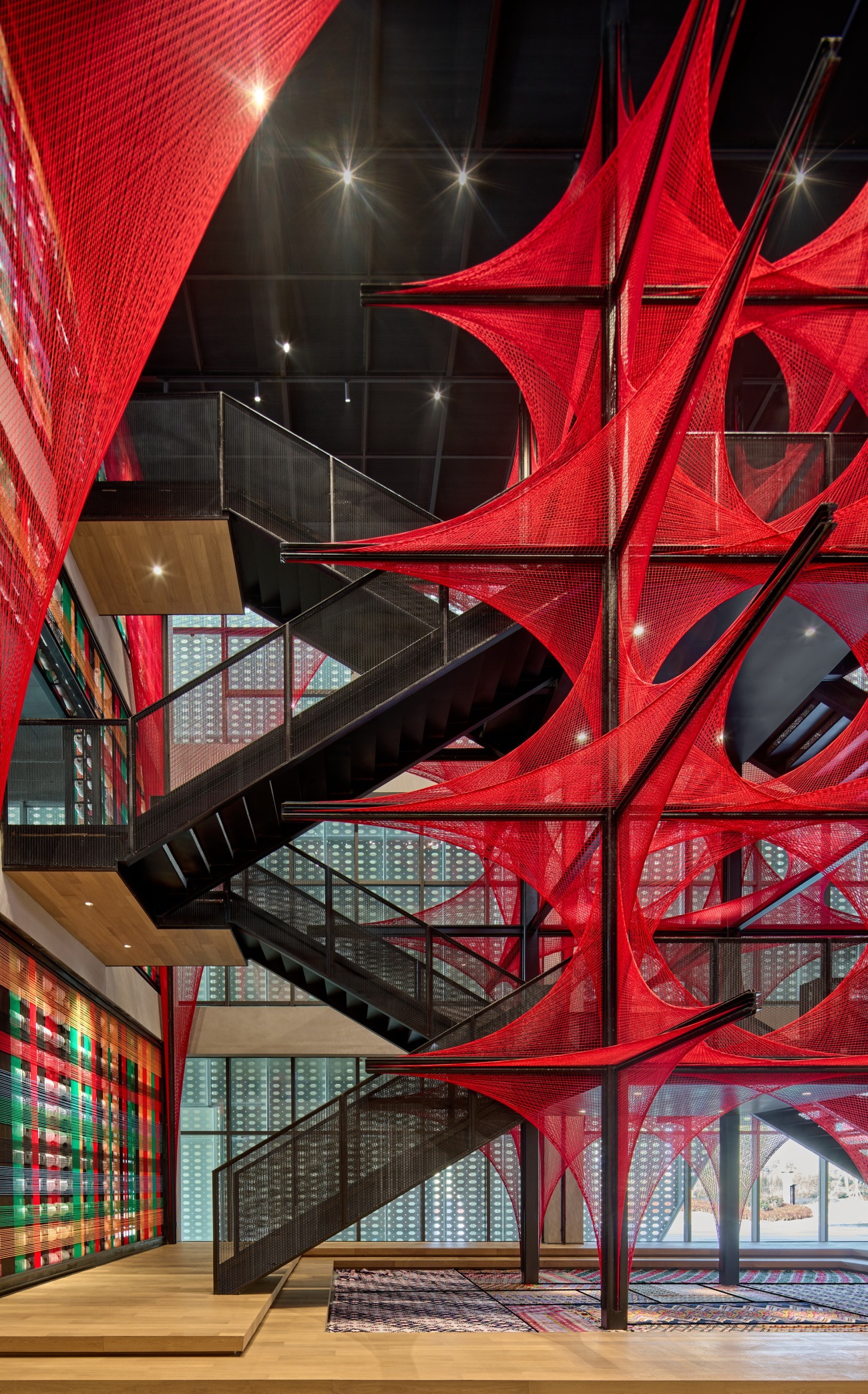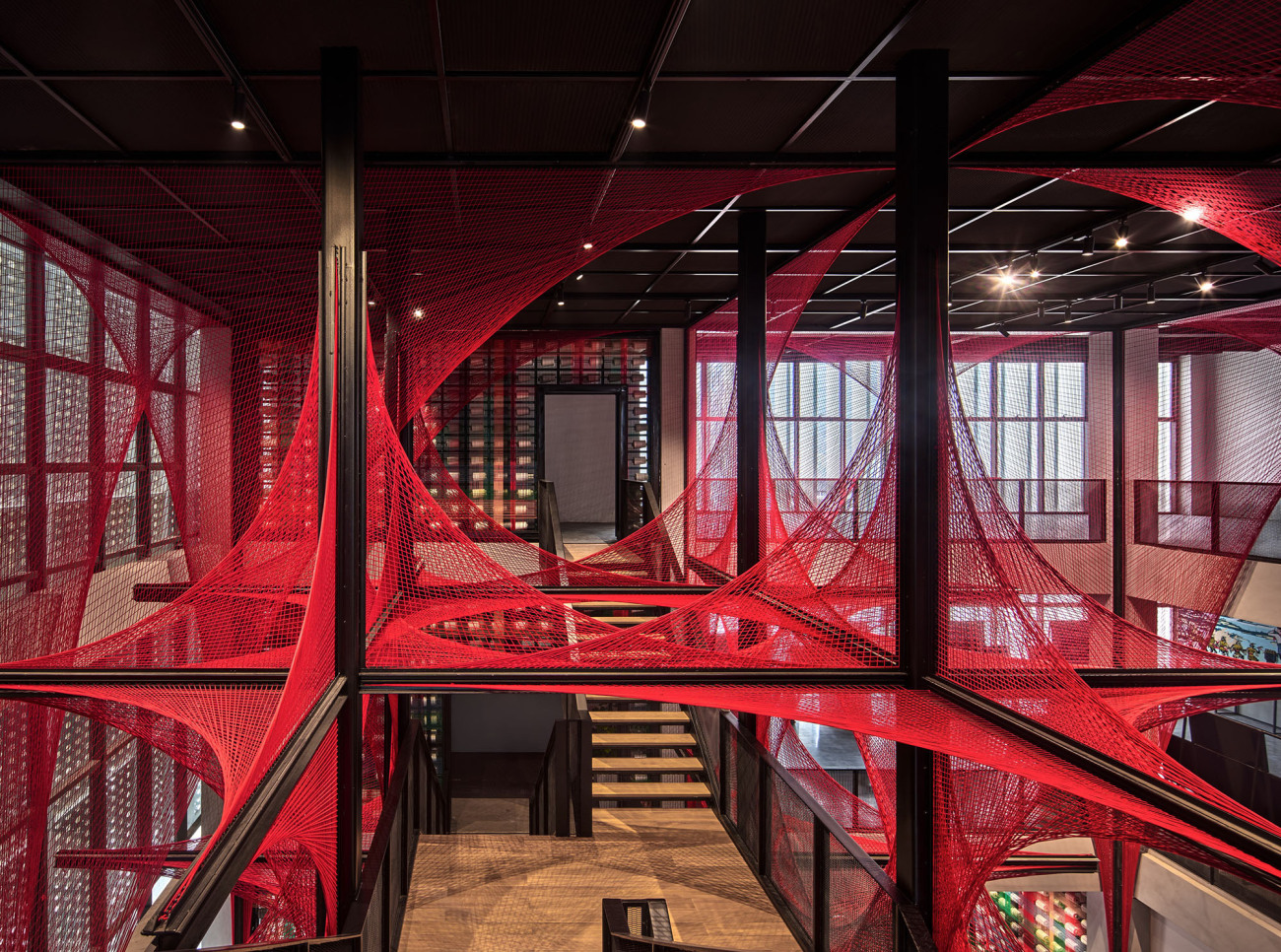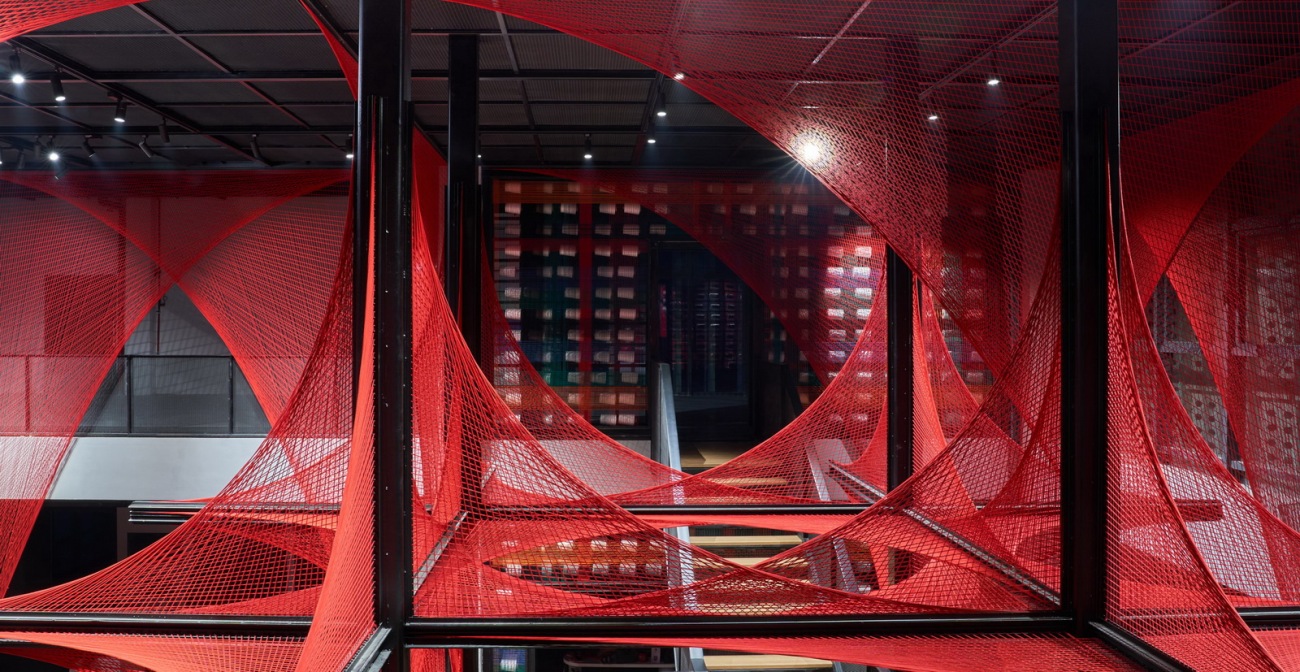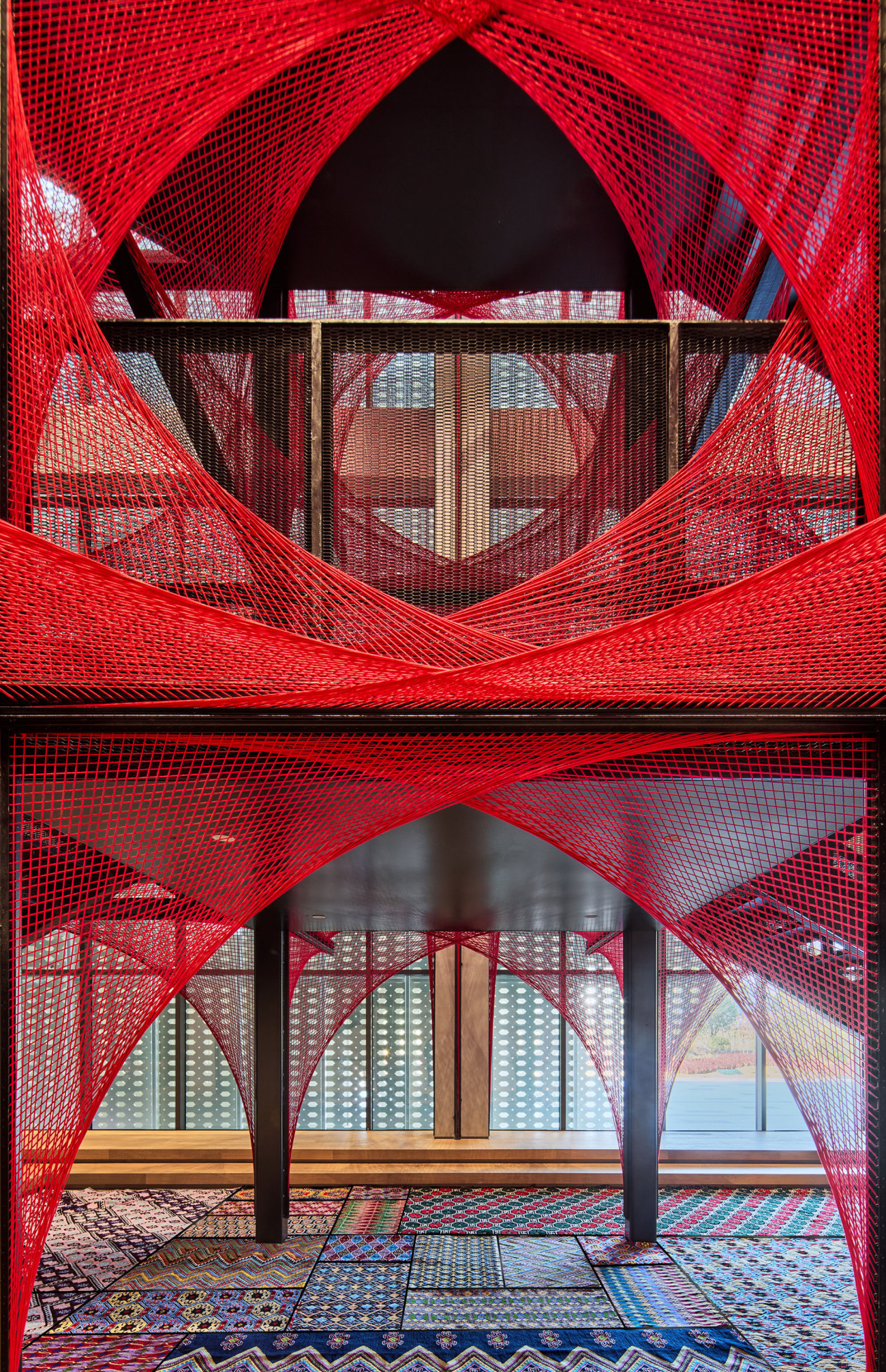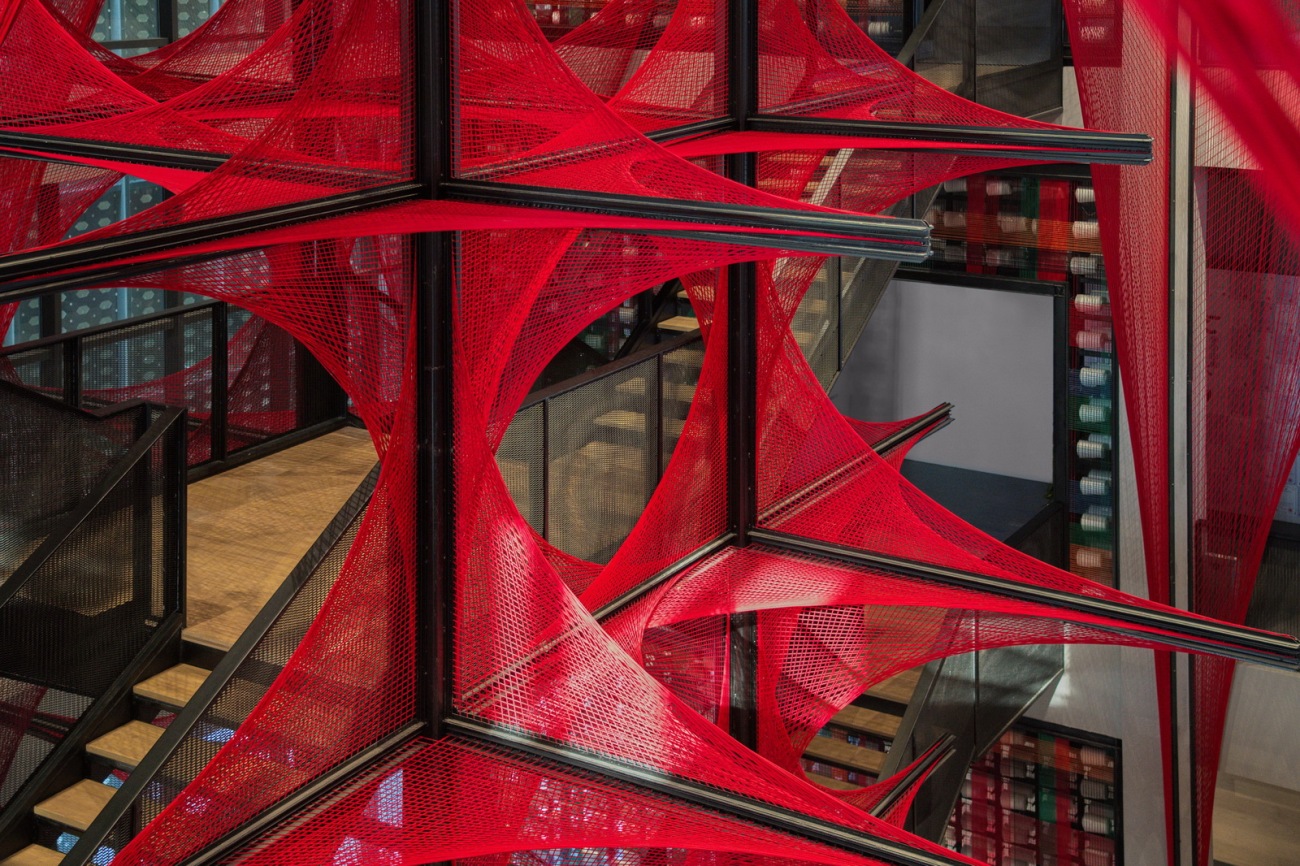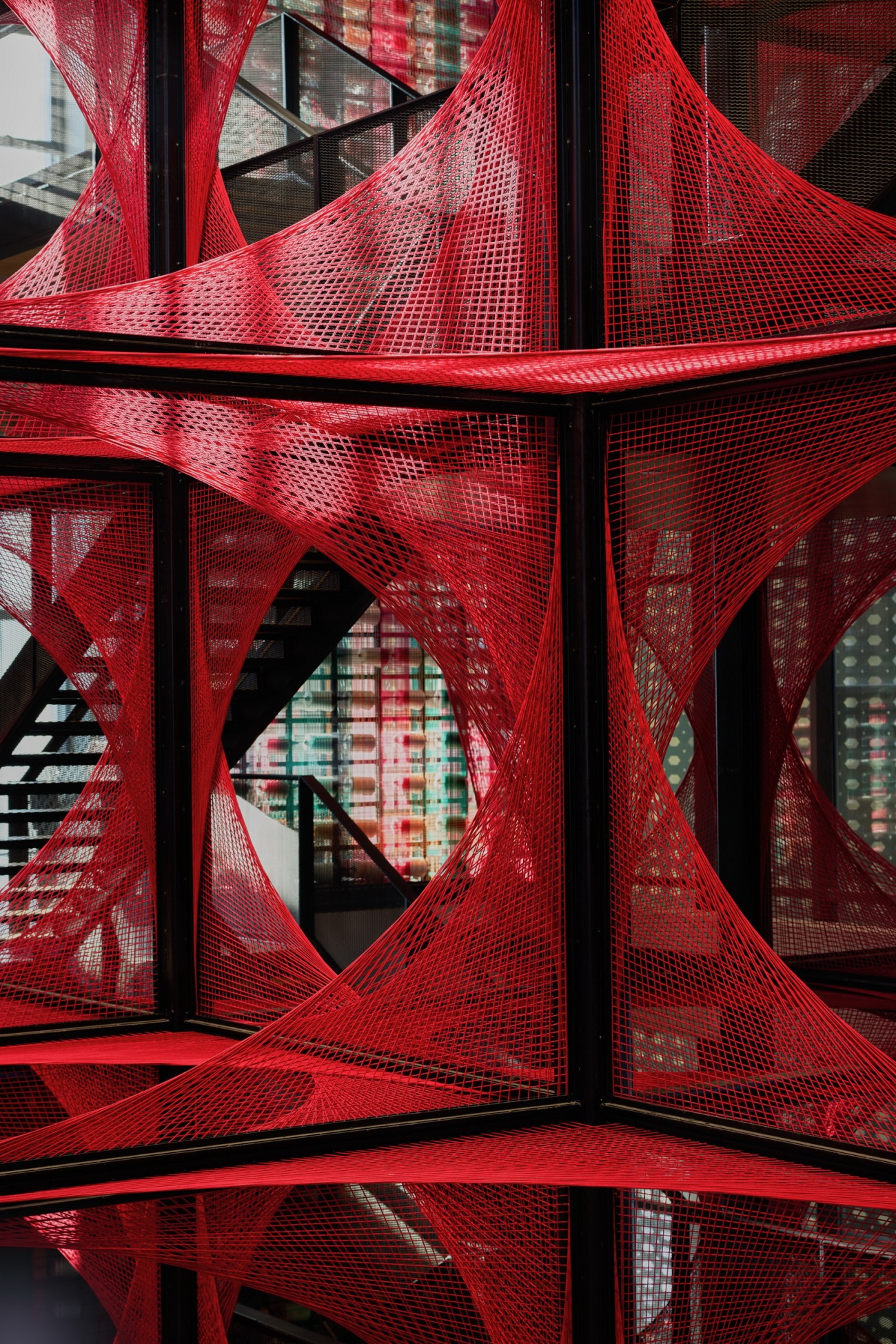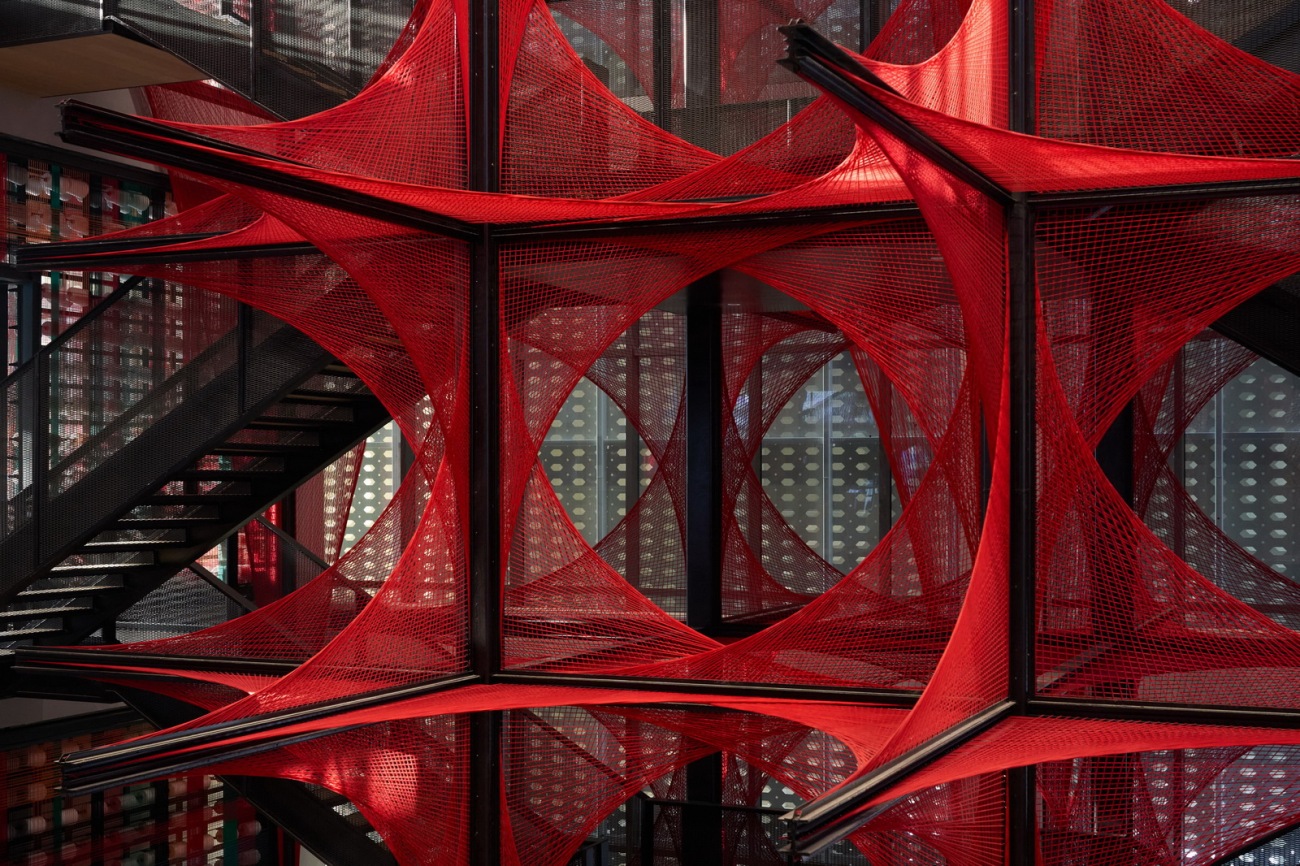文化是人类超遗传的记忆,它将过去的一切保存下来。
——尤·鲍·鲍列夫
Culture is the super-genetic memory of human beings; it preserves everything from the past.
--Yury Ivanovich Borisov
西兰卡普(花铺盖)给人的感觉,与土家族方言的气质完全吻合——从最土地和生活里来,带着大地的丰饶和烟尘,更一致的是,若不加以干预它们都将走向消亡。
The way Xilan Kapu, also known as Tujia Brocade, makes people feel is similar to that of the Tujia dialect. That is, they are closely connected to the richness of the land and daily life. Perhaps more importantly though, they are both heading towards extinction if left unprotected.
2022年,位于湖南省张家界的中国土家织锦艺术博物馆核心空间设计施工完成。约宽8m、高13m、深8m的大型中央装置“土家之花”由15万米红色锦线牵拉编织而成,跃出“土地”直达穹顶,撼动之力让人不得不重新走近、探寻这一默默千年的传统手工艺。
The main area of the China Tujia Brocade Museum in Zhangjiajie, Hunan Province, was completed in 2022. The giant central installation, the “Flower of Tujia,” is 8m wide, 13m tall, and 8m deep. It is made of 150,000 meters of red brocade threads. It reaches all the way from the floor to the ceiling, compelling people to come closer and explore this traditional handicraft that has remained silent for thousands of years.
中国土家织锦艺术博物馆以国家非物质文化遗产——土家织锦手工艺为产业核心,张家界乖幺妹土家织锦委托风合睦晨空间设计完成馆内全部设计,其中以土家之花装置为核心的主体空间历时四个月完成。这场温哥华、北京、张家界的三地协作就像一次跨越时空的织锦打花,徐徐盛放。
The China Tujia Brocade Museum is dedicated to the Tujia brocade handicraft, which is considered to be part of the country’s national intangible cultural heritage. Zhangjiajie Guaiyaomei Tujia Brocade asked Fenghemuchen to design the interior of the museum. It took them four months to complete the central installation. This collaboration between Vancouver, Beijing, and Zhangjiajie is like a flower slowly blooming across time and space.
西兰卡普
Xilan Kapu
西兰卡普即土花铺盖﹐人们在“花铺盖”前冠以“土”字以标示这项民间工艺的土家族民族特点。西兰卡普以麻、棉纱为经,以多色彩的粗丝、毛绒线为纬,由织女在古老的木制腰机上反面挑织而成。
西兰卡普色彩热烈、结构严谨,纹样以菱形结构和斜线条为主,讲究几何对称和反复连续,2006年以“土家织锦”为名被列入首批国家级非物质文化遗产名录。
Xilan Kapu features warm colors and a rigorous structure dominated by geometric symmetry and repeating diamonds and diagonal lines. In 2006, it was included as part of the first batch on the national intangible cultural heritage list under the name “Tujia Brocade.”
Xilan Kapu is the local dialectal name of Tujia brocade, a traditional craft of the Tujia people. It is woven on a wooden waist loom using hemp or cotton yarn as the warp. Thick, multi-colored silk is used as the plush threads that form the weft.
— 中心装置“土家之花” —
Central Installation the “Flower of Tujia”
土中来,火样生
Born out of the earth and passion
对土家族织女来说,西兰卡普通经断纬、多达30道工序的制作过程就像三餐和劳作一样自然。她们把土家古老先民对太阳之于生命之火的原始奇想,和对生活热烈、祥和的渴盼全部织进了“文采斑斓可见”的西兰卡普中,织机千年未停转。
For the Tujia women who weave these patterns, completing the more than 30 steps to produce Xilan Kapu is like breathing. They weave the ancient Tujia people’s idea of the sun as the fire of life and their burning and peaceful longing for life into the “colorful and visible” Xilan Kapu. This loom technique has been used for thousands of years.
▽中厅概念手绘
Concept sketch of the atrium
▽中厅拆解图
Diagram of the atrium components
在原始场地14米挑高的空间条件下,风合睦晨将这种单面纹样做了一次象征性的三维展开——20根钢结构骨架横纵穿插,红色锦线依附钢架逐根牵拉、固定而成,从织锦纹样中提取的菱形结构在正、侧、俯、仰的360°观看下清晰可见。
Fenghemuchen created a symbolic three-dimensional expansion of the single-sided pattern in the 14-meter-high space. The red brocade threads are attached and fixed to the frame, which is made of 20 steel bars. The diamond-shape structure inspired by the iconic pattern of the Tujia brocade is clearly visible from all angles.
在黑色骨骼与红色血液的虚实相交中,织机上的土家族血脉奔涌而来,生命之火从土壤中开出,“土家之花”绽放——散落在时光深处的原始生命踏入五光十色的商品社会,神采无极、能量毕现。
At the intersection of the black bones and red blood is the inheritance of the Tujia people, whose fire of life bursts out of the earth. The “Flower of Tujia” is blooming, connecting the primitive life scattered in the depths of time to the colorful and energetic commercial society.
— 场所精神 —
Spirit of the Venue
从古老传说到新想象
From Ancient Legends to New Imaginings
以“土家之花”为核心的空间更为宝贵的是其巧妙结合场地、实用、精神与观看的艺术属性。
The space around the “Flower of Tujia” is even more valuable thanks to the clever combination of the venue, utility, spirit, and artistic attributes.
▽楼梯概念手绘
Concept sketch of the stairs
垂直交通由两组钢制楼梯折线上升打通,并通过两处位于装置中心的平台连通,使楼梯与中心装置形成互看、融合。工业属性的楼梯线性结构来自西兰卡普纹样中的六边形,并同时应用在外围钢结构的镂空形上。当精微的图形浮出,展开成超乎经验的宏大,空间场所的矛盾与张力将呼唤新的想象。
A vertical passage is created by two steel staircases, which are connected by two platforms located at the center of the installation, bringing the staircases and the installation together. The linear structure of the industrial staircases is derived from the hexagon found in the Xilan Kapu pattern. It is also used in the hollow shape of the outer steel structure. When the subtle graphics emerge and unfold, the contradiction and tension of the space invite new imaginings.
楼梯与装置底部架空挑起,西兰卡普纹样铺地,人可以自由进出、席地而坐,这种设计同时回应了土家族干阑式建筑——吊脚楼的形制。设计最大限度将空间权利留给进入者,以此构筑完整鲜活的场所精神。
The bottom of the staircases and the installation are raised, and the floor is paved in Xilan Kapu patterns to allow visitors to access the space and sit on the floor. The design also echoes the stilted buildings of the Tujia people and maximizes the space for the entrants to fulfill the spirit of the venue.
中央区域外,设计使用白橡木、肌理漆、金属网、水磨石等简洁材料。在灰黑空间基底上,立面和顶大量使用白色纱锭与五色彩线阵列交纵,以此对外围空间进行半遮蔽,将空间视觉焦点始终引向中央。
Outside the central area, the design incorporates simple materials like white oak, textured paint, metal mesh, and terrazzo. Against the gray-black background, a large number of white spindles intersect with five-color threads across the facade and roof to slightly shield the peripheral space and direct the visual focus to the center.
在完整简洁中环游,空间没有多余的炫技笔触,一切都集中而有力,它们共同塑造了一个身份明确,与地景文脉和精神属性紧握相连的空间,它的来路与目标都清晰。
It can be seen when traversing the space that it is free of showy techniques, instead focusing on a concentrated and powerful display. Everything works together to create a space with a clear identity, origin, and aim that is tightly connected with the landscape, culture, and spiritual attributes.
对话
Dialogue
张家界乖幺妹土家织锦创始人 丁世举
风合睦晨主创设计师 陈贻、张睦晨
Ding Shiju, founder of Zhangjiajie Guaiyaomei Tujia Brocade
Chen Yi and Zhang Muchen, Fenghemuchen designers
— 空间价值 —
Value of the Space
穿过逆流,重塑语汇
Journey upstream and reshape the language
如有逆流,便要逆流而上。
If there is a current, journey upstream.
一个行业里的兴衰演变并不轻易为外界所知,土家织锦作为非遗民艺自然也不例外。织女的专注与匠心令人感到安宁,但同时显现的是传统手工艺和青睐高效便利的现代生活之间,无论设计、实用性还是运作模式间的断层。
The rise and fall of an industry is not easily observed by the outside world. Tujia brocade is no exception. The diligence and ingenuity of the women who weave the patterns is reassuring, but there is a gap between traditional crafts and modern life. The modern lifestyle favors efficiency and convenience, regardless of the design, practicality, or mode of operation.
设计使用更符合时代审美和当代意识的艺术形式,灵性的手将传统技艺放置在新空间里。艺术之外,随之而生长的趣味、情感、进步、信念等等终将为这项技艺重塑自己的语汇和价值。
The design features modern aesthetics and art forms, skillfully placing traditional skills in the new space. The interest, emotion, progress, and faith that grow along with art will eventually reshape the language and value of the craft.
如果无人继承传诵,博物馆里陈列的物品是没有生命力的,而我们需要“活”的技艺,这也是业主及风合睦晨的初心和寄望。
The objects displayed in the museum will be lifeless if they are not passed down to future generations. We need living skills. This is also the original aspiration and hope of the client and Fenghemuchen.
“土家铺盖,西兰卡普,美的花布,美的明珠
织呀织哟,织呀织哟,金凤凰就从织锦中飞出…”
“Tujia brocade, Xilan Kapu, beautiful floral cloth, gorgeous pearl
Weave, weave, weave, weave, a golden phoenix flies out of the tapestry”
▽大厅平面图
项目名称|中国土家织锦艺术博物馆-土家之花
项目地点|湖南 张家界
项目面积|1100平米
完工时间|2022年9月
硬装设计|风合睦晨空间设计
艺术装置|风合睦晨空间设计
主创设计|陈贻、张睦晨
设计团队|李武杰、杨志强、肖益、杨彦蓉、张旭、曾伟
项目业主|张家界乖幺妹土家织锦
施工单位|湖南一久建筑装饰工程有限公司
项目摄影|风合睦晨空间设计
项目视频|风合睦晨空间设计
文案策划|NARJEELING那几岭
项目策划|楽品牌策略机构
更新日期:2023-04-27 15:03:31
非常感谢 风合睦晨 带来的精彩项目, 查阅更多Appreciations towards Fenghemuchen for sharing wonderful work on hhlloo. Click to see more works!

